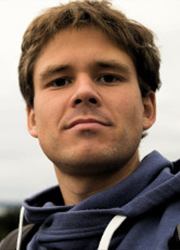Haidekker Galambos Tamás
ContactDepartment of PhysicsUniversity of Basel Klingelbergstrasse 82 CH-4056 Basel, Switzerland
|

|
Short CV
2017-present: Ph.D. student in the Condensed Matter Theory & Quantum Computing group at the University of Basel, supervisors: Prof. Klinovaja and Prof. Loss2017: Diplome d´Ingénieur des Arts et Manufactures (Ecole Centrale Paris, ECP)
2016/2017: Master's Thesis at BME: Development of Path Integral Monte Carlo simulations in magnetic field, Supervisor: Dr. Tőke Csaba
2015-2017: M.Sc. in Physics at the Budapest University of Technology and Economics (BME), Budapest, Hungary
2014/2015: Bachelor's Thesis at BME: A simple application of the Path Integral Monte Carlo method, Supervisor: Dr. Tőke Csaba
2012-2014: Double Degree Programme (T.I.M.E.) at Ecole Centrale Paris (ECP), Paris, France
2010-2015: B.Sc. in Physics at the Budapest University of Technology and Economics (BME), Budapest, Hungary
Publications
Show all abstracts.| 1. | Crossed Andreev reflection in spin-polarized chiral edge states due to the Meissner effect |
| Tamás Haidekker Galambos, Flavio Ronetti, Bence Hetényi, Daniel Loss, and Jelena Klinovaja. Phys. Rev. B 106, 075410 (2022); arXiv:2203.05894.
We consider a hybrid quantum Hall-superconductor system, where a superconducting finger with oblique profile is wedged into a two-dimensional electron gas in the presence of a perpendicular magnetic field, as considered by Lee et al., Nat. Phys. 13, 693 (2017). The electron gas is in the quantum Hall regime at filling factor
ν=1. Due to the Meissner effect, the perpendicular magnetic field close to the quantum Hall-superconductor boundary is distorted and gives rise to an in-plane component of the magnetic field. This component enables nonlocal crossed Andreev reflection between the spin-polarized chiral edge states running on opposite sides of the superconducting finger, thus opening a gap in the spectrum of the edge states without the need of spin-orbit interaction or nontrivial magnetic textures. We compute numerically the transport properties of this setup and show that a negative resistance exists as a consequence of nonlocal Andreev processes. We also obtain numerically the zero-energy local density of states, which systematically shows peaks stable to disorder. The latter result is compatible with the emergence of Majorana bound states.
| |
| 2. | Superconducting Quantum Interference in Edge State Josephson Junctions |
| Tamás Haidekker Galambos, Silas Hoffman, Patrik Recher, Jelena Klinovaja, and Daniel Loss. Phys. Rev. Lett. 125, 157701 (2020); arXiv:2004.01733.
We study superconducting quantum interference in a Josephson junction linked via edge states in two-dimensional (2D) insulators. We consider two scenarios in which the 2D insulator is either a topological or a trivial insulator supporting one-dimensional (1D) helical or nonhelical edge states, respectively. In equilibrium, we find that the qualitative dependence of critical supercurrent on the flux through the junction is insensitive to the helical nature of the mediating states and can, therefore, not be used to verify the topological features of the underlying insulator. However, upon applying a finite voltage bias smaller than the superconducting gap to a relatively long junction, the finite-frequency interference pattern in the non-equilibrium transport current is qualitatively different for helical edge states as compared to nonhelical ones.
| |
| 3. | Path-integral Monte Carlo study of electronic states in quantum dots in an external magnetic field |
| Csaba Tőke and Tamás Haidekker Galambos. Phys. Rev. B 100, 165136 (2019); arXiv:1905.07802.
We explore the correlated electron states in harmonically confined few-electron quantum dots in an external magnetic field by the path-integral Monte Carlo method for a wide range of the field and the Coulomb interaction strength. Using the phase structure of a preceding unrestricted Hartree-Fock calculation for phase fixing, we find a rich variety of correlated states, often completely different from the prediction of mean-field theory. These are finite temperature results, but sometimes the correlations saturate with decreasing temperature, providing insight into the ground-state properties.
| |
| 4. | Path-integral Monte Carlo simulation of time-reversal noninvariant bulk systems with a case study of rotating Yukawa gases |
| Tamás Haidekker Galambos and Csaba Tőke. Phys. Rev. E 97, 022140 (2018); arXiv:1702.01710.
We elaborate on the methodology to simulate bulk systems in the absence of time-reversal symmetry by the phase-fixed path-integral Monte Carlo method under (possibly twisted) periodic boundary conditions. Such systems include two-dimensional electrons in the quantum Hall regime and rotating ultracold Bose and Fermi gases; time-reversal symmetry is broken by an external magnetic field and the Coriolis force, respectively. We provide closed-form expressions in terms of Jacobi elliptic functions for the thermal density matrix (or the Euclidean propagator) of a single particle on a flat torus under very general conditions. We then modify the multislice sampling method in order to sample paths by the magnitude of the complex-valued thermal density matrix. Finally, we demonstrate that these inventions let us study the vortex melting process of a two-dimensional Yukawa gas in terms of the de Boer interaction strength parameter, temperature, and rotation (Coriolis force). The bosonic case is relevant to ultracold Fermi-Fermi mixtures of widely different masses under rotation.
|
